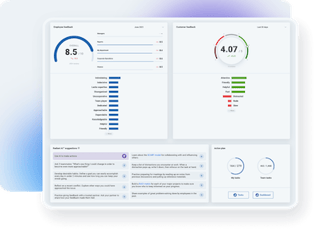
Manager Enablement: The Future of Performance Management
In today's fast-changing business world, companies are always looking for new strategies to stay competitive and innovative. One big shift we're seeing is a transition from traditional performance management to an emphasis on manager enablement.
Manager enablement represents a way forward for performance management workflows. Instead of relying on ratings, it gives managers the training, resources, and support they need to develop and engage their people. This approach replaces punitive action with coaching from an improvement-focused mindset that prioritizes collaboration, growth, and building trust between managers and their teams.
With positive enablement, managers learn how to have effective one-on-ones, give constructive feedback, and set goals focused on the employee's personal development. This leads to more engaged, invested employees. Annual reviews still have a role in making compensation decisions and providing feedback, but they shouldn't be the main event. Ongoing coaching and development is now seen as much more important for performance.
The shift to enablement is a big change made even bigger by the advent of AI technologies. Companies that support manager success set their people up for success as well, provided they can balance modern performance analytics with future-oriented enablement. The ones that succeed will see immediate dividends, including improved retention, innovation, and results.
This article breaks down the big shifts in workplace strategies with a spotlight on manager enablement. We’ll talk about how this new approach is currently changing the game in top-performing organizations.
What are Performance Management and Manager Enablement?
Performance management has traditionally been a key process for organizations to set goals, track progress, and give feedback to employees. The idea was to make sure everyone was working towards the same big-picture objectives. Annual reviews were a major part of formalizing this process. Employees frequently perceived performance management as inflexible and hierarchical. It was seen as more stick than carrot, focusing on ratings and accountability over growth.
Manager enablement flips the script. Instead of just overseeing their teams, managers become coaches and collaborators. They get training and resources to have better one-on-one meetings, give constructive feedback, and nurture their team members' professional development. With manager enablement, the annual evaluation is not the focus. Ongoing mentoring takes center stage. This approach aims to empower employees and align their growth with organizational goals. But it does so through relationship-building and support rather than rigid tracking and ratings.
Performance management and manager enablement both aim to promote improvement and alignment. But enablement does it through managers who are invested mentors rather than detached overseers. With some foresight and empathy from leadership, manager enablement can transform teams from disengaged onlookers to active participants. .
When it comes to performance management, three big focus areas are:
- Goal Alignment: This is about making sure everyone’s goals connect to the bigger company goals. For example, the sales team sets quarterly targets that ladder up to the overall revenue target. This way, everyone is rowing in the same direction. Performance management aligns employee and company goals.
- Progress Monitoring: Performance management involves regularly checking in on progress toward goals through tools like status reports and milestone tracking. A project manager, for instance, might use a software tool to track progress toward project milestones and facilitate employee progress.
- Feedback: Structured feedback moments, like during one-on-one meetings or annual reviews, are built into the process. This regular feedback promotes continuous improvement and growth by providing insights into performance. Formal feedback mechanisms aim to drive continuous improvement.
With manager enablement, companies take a different approach:
- Resource Provisioning: Managers get access to tools, learning resources, training, and anything else they need to be successful. For example, providing data analysis software and leadership training to help managers gain insights and lead effectively.
Collaborative Growth: It’s about managers and teams working together in a growth-oriented way as opposed to a top-down leadership style. Brainstorming as a team on projects and co-creating development plans fosters joint ownership and engagement. The focus is on collaborative development. - Future-oriented Development: Enablement focuses on developing skills for the future, not just current roles. With the right encouragement, managers can nurture future leaders through a formal mentorship program or tailor personalized career and skill development plans for individual employees. Future-oriented development empowers managers to help employees build skills for future roles. New technologies like predictive analytics and real-time performance feedback help managers look to the future to create more personalized development plans than ever before.
In summary, performance management relies on processes to align, monitor, and provide feedback. Enablement gives managers resources for growth while also focusing on collaboration and future skills.
The Differences Between Performance Management and Manager Enablement
Performance management and manager enablement differ in their approach to employee engagement. Performance management used to be the gold standard, focusing on measurable performance metrics to gauge performance. Its standards were well-known throughout top-performing organizations. And yet, since 2020, global engagement has dropped from 36% in Q1 2020 to 30% in Q1 2024.
Clearly, traditional standards of performance management are not actively engaging workers. But it’s worse than that, as the same polling data shows that in the same span of time, the number of actively disengaged workers has risen. About 1 in 7 workers in 2020 identified as actively disengaged. Closing out 2024, that number was almost 1 in 5, or around 18%.
What does this mean for performance management? In short, the standard metrics are not enough to re-engage modern employees. Companies now see the value of transitioning away from KPI-focused performance management to a manager enablement workflow, which focuses on the tools and skills that managers need to coach teams and encourage engagement, rather than simply measure it.
Let’s look at the differences between these two methods with three key focuses:
1. Time Frame Focus
- Performance management relies heavily on historical evaluations through methods like annual performance reviews. These reviews dissect an employee’s achievements, shortcomings, and overall effectiveness over the past year. The focus is retrospective, sometimes failing to account for future potential.
- The problem with this method is that employees often can’t relate the old feedback to their current work. A distance forms between their goals and their perception of their management’s career progress for them. Even if they feel recognized, they may not feel well-recognized, such as for recent work that is relevant to their current progress.
Studies show that 45% of employees who receive proper recognition for recent work have a lower turnover rate two years after their review. Employees who feel that the feedback is valuable are 5x more likely to be engaged. This is why manager enablement focuses on the tools needed to help managers encourage employees, rather than simply measure them.
2. Collaborative Approach Focus
- Performance management tends to operate in a top-down, hierarchical manner. Upper management defines strategies and goals that trickle down. Employees are expected to comply with little input. This nurtures a culture of merely meeting expectations.
- Manager enablement favors collaborative dynamics between managers and teams. Modern feedback systems create a 360-degree feedback channel where employees receive anonymous feedback from their peers and managers with a guided focus on personal growth. Rather than leadership issuing employees directives, managers enable participation and idea-sharing. Agile methodologies that use collaborative goal-setting and decision-making are encouraged to promote a workplace culture of continuous improvement.
- In conventional performance management terms, “improvement” means better KPIs. In modern manager enablement terms, “improvement” translates to communication, goal-setting, and collaboration, proven ways to increase productivity and reduce turnover in modern employees.
3. Developmental Objectives Focus
- The primary objective of traditional performance management is evaluation. Employees are assessed based on how well they meet benchmarks and metrics. This can restrict skill development to meet preset definitions of success.
- Enablement focuses on nurturing well-rounded skills and competencies. Managers devote time to preparing employees for future challenges and leadership roles through training programs and stretch assignments. The focus is developmental.
- Manager enablement uses a future-centric approach centered on nurturing growth and development. AI-assisted feedback tools allow managers to review vast amounts of performance data in an instant to deliver high-quality, personalized reviews and career progress plans for each employee. This reinforces the perception that feedback is unbiased, valuable, and personal, factors that will encourage retention. Managers equipped with these tools have ongoing collaborations with employees to create career progression plans, develop skills, and discuss future opportunities. The emphasis is on the future versus the past.
- In an age where 47% of employees report being less likely to seek new jobs if their current employers encourage skill development, top-performing organizations need to equip managers with the tools they need to upskill their teams. The goal is to make employees feel like their current job is the job that supports them, both now and in their future careers.

The Benefits of Manager Enablement
Embarking on manager enablement can spark positive changes in an organization - from the work environment to productivity. This is especially important today, when over 1 in 2 employees are so disengaged that they are actively open to leaving their current jobs. These benefits give managers the tools they need to keep their talented teams where they belong: investing in their current organization by developing new skills and relationships.
Increased Employee Engagement:
- Positive Work Environment: Enablement establishes a positive and supportive work culture where employees feel valued through collaboration and recognition of their unique contributions. For example, a manager taking the time to acknowledge and praise the diverse strengths of each individual team member can greatly boost morale and motivation.
- Individual Growth and Satisfaction: Employees experience increased personal growth and job satisfaction that goes beyond their formal job duties and responsibilities. As an illustration, a manager enabling an employee to take a course or training program that aligns with and advances their career aspirations shows investment in their development. This can significantly improve employee happiness and loyalty.
Engagement Case Study: When Atrium Hospitality partnered with Macorva, they needed an employee feedback solution that empowered managers to oversee HR workflows for 7,500 employees across nearly 100 locations. Our AI-powered platform provided managers with automated, personalized action plans, enabling them to respond to employee feedback effectively.
Within the first month of integration, Atrium completed over 500 manager-led actions and achieved engagement levels in the top 25th percentile. By leveraging Radiant AI coaching plans, Atrium empowered employees at every level with individualized progress plans—seamlessly aligning manager goals with employee expectations, all without increasing HR costs.
This example demonstrates how quickly engagement and enablement can be enhanced with the right solution.
Empowering Managers with AI coaching at Atrium Hospitality.
Improved Performance:
- Skill Enhancement: Manager enablement involves facilitating continual enhancement of employees' skills through training and development opportunities. This directly paves the way for performance improvements that enhance managers’ abilities to rally their teams and achieve organizational goals. For instance, a manager setting up regular tailored training sessions to help hone specialized skills within the team will lead to increased productivity and performance.
- Achievement of Organizational Goals: With collaborative efforts and enhanced individual skills, teams become empowered to efficiently accomplish goals and drive organizational success. When development is aligned with goals, employees contribute at a higher level. Picture a team working cohesively to achieve their ambitious project goals well ahead of schedule, adding value for the company.
Reduced Turnover:
- Employee Retention: Managers who are enabled with real-time feedback and other performance resources can better understand and address employee needs, creating a supportive environment that significantly reduces turnover rates. A case in point would be a manager implementing flexible work hours or locations to accommodate an employee's outside responsibilities. This adaptable approach encourages loyalty and reduces the likelihood of talent loss.
- Cost Reduction: Reduced turnover translates to substantial cost savings by decreasing recruitment, hiring, onboarding and training expenses. Retaining experienced employees over the long term saves the company considerable resources compared to repeatedly bringing on new hires
- Long-term Loyalty: Only 36% of new employees feel encouraged to learn new skills at their organizations. This number drops to 24% for employees who have worked there for three years or more. Managers who are enabled with the tools needed to get mid-level and senior employees back into upskilling and improvement funnels can help them grow, engage, and feel like their current jobs are worth it.
Increased Innovation:
- Fostering Creativity: Manager enablement cultivates a dynamic environment for creative solutions and ideas to emerge, fostering innovation, adaptability and big-picture thinking. Imagine a brainstorming session where a manager actively encourages open dialogue and wild ideas. This leads to the conception of groundbreaking solutions and products.
- Adaptive Solutions: This approach pushes teams to evolve, adapt, and think outside the box, cultivating solutions aligned with changing market landscapes and consumer demands. A forward-thinking manager could encourage exploring new technological advancements to improve product offerings and experiences, driving competitive advantage.
- Trending Technologies: As of Q4 2024, 93% of Fortune 500 companies have deployed AI in their organization’s performance management stack. Despite this trend, most of them (85%) have not communicated a clear strategy for further AI integration or worked efficiently with their managers to scale these solutions. Manager enablement gives them the tools to understand changes in their organizations. They can then communicate this understanding to their teams and promote a trickle-down culture of technology acceptance and productivity.
Technology planning case study: Henkel, a global consumer goods enterprise, used Macorva’s manager enablement solution to introduce more future-oriented feedback systems to their HR workflows. The AI-powered management system generated insights after only three months, helping managers generate proactive action plans for their employees. They also validated succession plans with 360-degree feedback provided by AI-assisted performance reviews. This allowed Henkel’s team to spot areas for improvement, build a stronger culture of trust with their employees, and improve team dynamics with anonymous, actionable feedback.
The Promise of Manager Enablement: High Performance Culture
Manager enablement is an approach to performance management that focuses on empowering managers to be successful enablers for their employees. This means shifting the focus from just evaluating performance to creating an environment that encourages growth and development, collaboration, and innovation.
One of the key benefits of manager enablement is that it can help to create a high-performance culture. When managers are empowered to focus on developing their employees, they are more likely to create a workplace where everyone feels nurtured and motivated to give their best. This can lead to increased engagement, productivity, innovation, and employee retention.
While a growth mindset can help managers motivate their team, it can become overly focused on metrics and statistics. Before you know it, your managers could be falling back on traditional management models by obsessing over KPIs and single performance reviews. This can lead employees to doubt the authenticity of their performance evaluations and lose trust in their managers’ career progression plans.
AI-assisted feedback tools and predictive performance analytics can step in and return trust to the modern manager-employee dynamic. AI-powered feedback surveys can be created free from managerial bias. At the same time, AI analytics give managers the tools they need to proactively tailor development and progression plans to each employee’s goals, abilities, and areas of improvement.
When managers have a deep understanding of their employees' strengths and weaknesses, they are better equipped to make informed decisions about how to allocate resources and assignments. This can lead to better outcomes not only with profitability but also with employee trust scores, retention rates, and engagement.
When properly deployed and assisted by modern technology, manager enablement can create a more positive and productive work environment. When employees feel supported and valued by their managers, they are more likely to hit high engagement targets and feel like they are part of a team. This can lead to a more enjoyable and productive work experience for everyone.
In the next post in this series, we will discuss how to take these theories and implement manager enablement at your organization.
Editors note: this blog was originally published in September 2023 and has been updated for accuracy and comprehensiveness.







